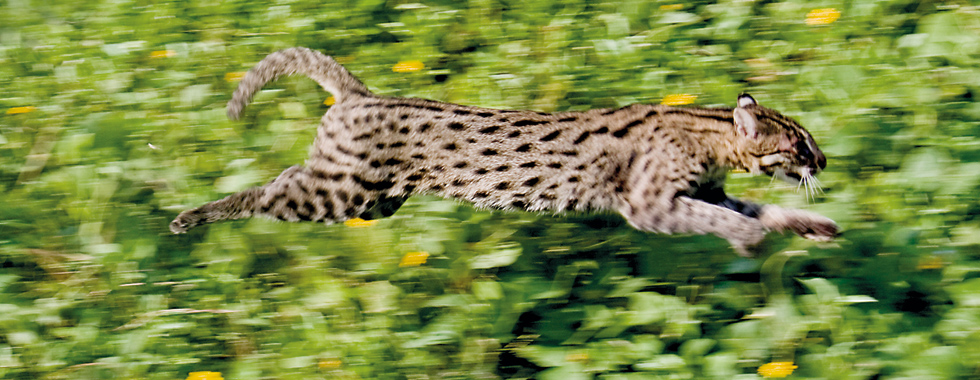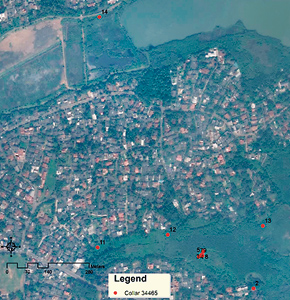A chance to survive and thrive
It was a poignant moment as Sri Lanka’s first ever collared fishing cat (Prionailurus viverrinus) was released to the Sri Jayawardenapura Sanctuary last week. The fishing cat was fitted with a Lotek Wildcell SLG GPS-GSM collar that will track his movements and help scientists record and study the ecology and behaviour of these fishing cats in an urban habitat of Sri Lanka.
This is also the first time in the world that a fishing cat has been fitted with a GPS GSM collar whilst other studies have used VHF collars to track and study the movements of this wild cat.

The Collared Fishing Cat is released in Attidiya
Supported by the Department of Wildlife Conservation (DWC) and facilitated by the Environmental Foundation Limited (EFL), this fishing cat was tranquillised, measured, weighed and fitted with its collar before being released in the presence of a team of wildlife veterinarians, biologists, and conservationists. The cat was initially rescued after being caught trapped in a chicken coop in the outskirts of Ja-Ela. The male cat was then handed over to the DWC who, in turn, initiated this first of its kind Management Oriented project with the help of EFL.
This study is under the purview of wildlife conservationist and principal researcher of this initiative Anya Ratnayaka, along with co-researcher and Senior Scientist with the World Wildlife Fund (WWF) Dr. Eric Wikramanayake, project advisor Rukshan Jayewardene, project coordinator and Director Operations EFL Vimukthi Weeratunga, and field assistant Chandika Jayaratne.
Anya Ratnayaka said, “Our study attempts to learn more about the distribution and ecology of the fishing cat in urban habitats, so we can treat it as a charismatic flagship species to conserve the important wetlands and the ecological communities within them. The marshes and other wetlands they inhabit are being rapidly filled for housing developments, despite the important ecological role they play as sinks and drainages for flood water. Hopefully the presence of these fishing cats will bring more attention to the urgent need to conserve these ecosystems.”
“This is a first-of-a kind example of our commitment to saving this important species by studying their behavioural habits,” said Rukshan Jayewardene. “We must somehow ensure that despite rapid urbanisation, this species is given a chance to survive and continue to thrive.”
Building upon a previous study done in 2006 by Dr. Wikramanayake that was funded by the Smithsonian Institute and implemented through the Open University in Colombo, it was confirmed that there is a significant presence of fishing cats in the urban wetlands in and around Colombo. Dr. Wikramanayake stated that this current study will help understand the movement and ranging behaviour.
The GPS-GSM collar, which accurately reports the cat’s location every five hours will help scientists gain a better understanding of fishing cat behaviour, improve conservation interventions like habitat recovery and closely monitor its ability to adapt in new environments.

GPS point locations of fishing cat at Sri Jayawardenapura
The collar is fitted with an Etisalat SIM card that stores GPS points and relays this information every five hours via a SMS to the Ground Station, which is also fitted with similar Etisalat SIM card. The SMSs are then converted into data files via the Lotek software enabling the project team to keep track of the fishing cat’s whereabouts.
The collars and other tracking equipment were purchased through funds provided by the Rufford Small Grants Foundation, a UK based charity that supports nature conservation projects in the developing world. Commenting on this groundbreaking study, Dr. Tharaka Prasad, Director Wildlife Health at the DWC said, “We can now scientifically learn and follow proper adaptive management methods through this study.
There have been many instances where we have released trapped errant fishing cats within the same area, only to have them return and be killed. I hope that communities, relevant authorities and wildlife enthusiasts will respond favourably to such research and help in future conservation projects.”
The fishing cat was first rescued by the staff of Gaminie Vijith Samarakoon, Assistant Director of the DWC, Western region who said that within the past three months, over 20 fishing cats have been rescued and released and/or relocated. “However, we have no record of what happens to these animals after release. This is the first time we are tracking a translocated fishing cat and we hope that this study will help us to understand how they react to the translocation and adapt to the new situation.”
Commonly known as the Handun Diviya, the fishing cat is a medium-sized wildcat and is the second largest wildcat in the country. With the rapid urbanisation of marshlands and other wetlands, fishing cats in urban habitats are threatened by habitat loss.
The solitary living fishing cats are primarily nocturnal. They are very much at home in the water and can swim even under water. Females have been reported to range over areas of 4 to 6 km (1.5 to 2.3 sq mi), while males range over 16 to 22 km (6.2 to 8.5 sq mi). They mark their territory using cheek-rubbing, head-rubbing, chin- rubbing, neck-rubbing and urine spraying to leave scent marks.
The fishing cat is included on the CITES Appendix11 and is a strictly protected mammal by national legislation, the Fauna and Flora Protection Ordinance, over most of its range and poaching of this species is prohibited in Sri Lanka. “We urge people to call us if they cannot deal with a fishing cat in their properties. We will find a way to relocate and rehabilitate this animal which will ultimately help in the conservation of this species,” said Dr. Tharaka Prasad added.
“This is also a prime example of the commitment of likeminded people and corporations in saving our wildlife using cutting edge technologies,” said Vimukthi Weeratunga. “It is by working together that we can inform, educate and cultivate communities to recognise and respect these animals.”
comments powered by Disqus

